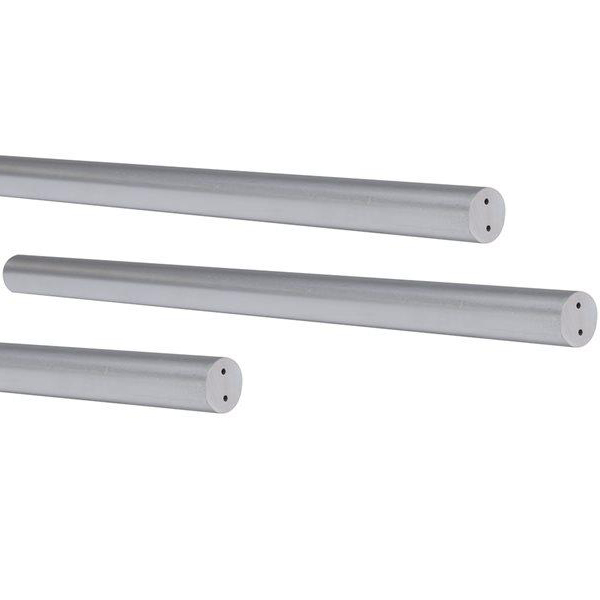精密機械加工の世界では、1ミクロン単位が重要であり、効率性が最優先されます、 2つのヘリカル冷却孔 カーバイド ロッド がゲームチェンジャーとして登場しました。螺旋状の2つのクーラントチャンネルを特徴とする、綿密に設計されたこれらの工具は、クーラント供給におけるパラダイムシフトを象徴し、要求の厳しい加工アプリケーションにおける性能の限界を押し広げます。
この包括的なガイドは、これらの最先端工具の複雑さを掘り下げ、その設計、利点、用途、そして精度、スピード、工具寿命が譲れない産業で急速に不可欠になっている理由を探る。
2ヘリカルクーラントホール超硬ロッドとは?
2ヘリカルクーラントホール超硬ロッドは、ロッドの中心軸の周りにらせん状に配置された2つのクーラントホールが特徴です。直線的なクーラント孔とは異なり、ヘリカル溝はコークスクリューのような経路をたどり、クーラントを切削界面に直接、旋回させながら供給します。

デザインを分解する:ヘリカルクーラントホールがいかに性能を高めるか
2つのヘリカルクーラントホール超硬ロッドの優れた性能は、クーラントの流れと切り屑排出を最適化する独自の能力から生まれ、利点の連鎖をもたらします:
- 目標冷却力: らせん状のデザインは、クーラントがらせん状の溝に沿って移動する際に、クーラントを外側に押し出す遠心力を発生させます。この標的を絞ったアプローチにより、切削ゾーンの最も困難な領域にもクーラントが確実に到達し、従来の方法と比較して優れた熱放散を実現します。
- 強化されたチップ除去: ヘリカルチャンネルによって引き起こされるクーラントの旋回運動は、切削界面から切り屑を効率的に浮き上がらせ、除去する強力なフラッシング作用を生み出します。これにより、切屑の再切削を防ぎ、熱の蓄積を低減し、より滑らかな仕上げ面を実現します。
- 切断力の低減: ヘリカル式クーラント供給システムによる潤滑と冷却の改善により、切削抵抗を大幅に低減することができます。この切削抵抗の低減は、工具の摩耗を最小限に抑え、工具寿命を延ばし、寸法精度を向上させます。
- 表面仕上げの向上: ターゲット冷却と効率的な切り屑排出の組み合わせは、加工ワークの優れた仕上げ面に貢献します。これは、金型製造や医療機器製造など、表面の完全性が重要な用途で特に重要です。
製造と材料科学精密さのシンフォニー
2つのヘリカル冷却孔を持つ超硬ロッドの製造には、高度な製造技術と材料科学への深い理解が要求される:
- 超硬グレードの選択: これらのロッドは一般的に、卓越した硬度、耐摩耗性、過酷な機械加工に耐える能力で知られる、超微粒子のサブミクロン炭化物グレードから作られています。一般的なグレードには、K10、K20、および特殊な微小粒グレードがあります。
- 精密ヘリカルドリル: ヘリカルクーラントホールは、放電加工(EDM)や特殊なガンドリル加工法などの高度なドリル加工技術によって形成されます。これらの工程により、最適なクーラント流量と工具性能に必要な正確な直径、ヘリカルピッチ、表面仕上げが確保されます。
- 品質管理と保証: ヘリカル・クーラント・ホールの完全性、寸法精度、ロッド全体の品質を確認するため、製造工程全体で厳しい品質管理措置が実施されている。
バリエーションをナビゲートする2つのヘリカルクーラントホールの種類 超硬ロッド
基本的な設計原理は一貫していますが、2つのヘリカルクーラントホールの超硬ロッドの領域では、特定の加工要件に対応するためのバリエーションが存在します:
- ヘリカルピッチと直径: らせんピッチ(らせんが一回転する間の距離)とクーラント孔の直径は、特定の用途向けにクーラントの流れと圧力分布を最適化するように調整することができます。
- 超硬グレードとコーティング: 超硬材種とコーティングの選択は、加工材料、切削パラメータ、希望する工具寿命によって異なります。断続切削や研磨材を加工する場合は、より強靭な材種を選択し、TiN、TiAlN、DLCなどのコーティングを施すことで、耐摩耗性と工具寿命をさらに向上させることができます。
- ロッドの寸法と公差: これらのロッドは、様々な加工用途に適合するよう、幅広い直径と長さを取り揃えています。厳しい寸法公差は、ツーリングシステム内での適切な適合と性能を確保するために非常に重要です。
表1:2つのヘリカルクーラントホールの多様性を探る 超硬ロッド
| 特徴 | 説明 |
|---|---|
| ヘリカルピッチ | 通常は5mmから20mmで、用途によって異なる。 |
| クーラントホール径 | 通常、0.5mmから3.0mmの範囲 |
| 超硬グレード | K10、K20、マイクロ・グレイン、その他特殊グレード |
| コーティング | TiN、TiAlN、DLC、その他の耐摩耗性コーティング |
| ロッド径 | 幅広い標準径とカスタム径をご用意 |
アプリケーションヘリカルクーラントホールが世界を変える
2 ヘリカルクーラントホール 超硬ロッドは、以下のような要求の厳しい様々な機械加工用途で活躍しています:
高性能機械加工:
- 航空宇宙産業: チタン、ニッケル合金、ステンレス鋼のような、発熱と切り屑排出が最も重要な高温合金からの複雑な部品の加工。
- 自動車製造: エンジン部品、トランスミッション部品、その他の重要な自動車部品を高精度で効率的に生産。
深穴掘削とボーリング
- 金型製作: プラスチック射出成形やダイカスト用の金型に、深く複雑な冷却溝を作る。
- エネルギー産業: 切りくずの除去と熱管理が重要な石油・ガス部品の深穴加工。
チャレンジングな素材:
- 硬化鋼: ヘリカルクーラントホールが提供する強化された冷却と潤滑は、高温を発生しやすく、工具の摩耗を加速させやすい焼入れ鋼を加工する際に非常に有益です。
- エキゾチック合金: 航空宇宙や医療用途で使用されるようなエキゾチック合金の加工では、満足のいく結果を得るために、特殊な工具と冷却戦略が必要となることが多い。
超硬棒サプライヤーの比較:市場概要
| サプライヤー | 所在地 | 価格帯(1個あたり、概算) | 特産品 |
|---|---|---|---|
| TRUER | 中国 | $30 – $900 | カスタマイズされた2つのヘリカルクーラントホール超硬ロッド幅広いグレード、直径、コーティング、競争力のある価格設定 |
| サンドビック・コロマント | スウェーデン | $40 – $1,100 | 高性能切削工具、ツーリングシステム、金属切削アプリケーションにおけるグローバルな専門知識 |
| ケナメタル | アメリカ | $35 – $1,000 | 高度な材料科学、要求の厳しい用途向けの金型ソリューション、革新と性能への注力 |
| イスカー | イスラエル | $38 – $1,050 | 革新的な工具形状で知られる金属加工工具、切削チップ、ツーリングシステム |
| 三菱マテリアル | 日本 | $42 – $1,150 | 切削工具、耐摩耗部品、先進材料、精度と信頼性の重視 |
表2:主要超硬ロッド・サプライヤー比較
ご注意ください: 価格は概算であり、超硬グレード、ロッド寸法、クーラント穴仕様、注文数量、市場の変動などの要因によって大きく異なる場合があります。正確で最新の価格情報については、常にサプライヤーに直接問い合わせることをお勧めします。
利点と限界:バランスのとれた視点
メリット
- 優れた冷却と潤滑: らせん状のクーラントホールは、狙いを定めた旋回力でクーラントを供給し、切削ゾーンに卓越した熱放散と潤滑をもたらします。
- チップ避難の強化: 旋回するクーラントの流れが効率的に切り屑を浮き上がらせて除去するため、切り屑の再切削を防ぎ、熱の蓄積を抑え、仕上げ面粗さを向上させる。
- 生産性の向上: 冷却と切屑排出機能が強化されたことで、切削速度と送り速度の向上が可能になり、加工全体の生産性が向上します。
- 工具寿命の延長: 熱の低減と切りくず処理の改善により、工具寿命が延び、工具コストとダウンタイムが削減される。
制限:
- より高いコスト: 2 ヘリカル冷却孔の超硬ロッドは、製造が複雑になるため、通常、単孔や中実の超硬ロッドよりも高価になります。
- 目詰まりの可能性: ヘリカルデザインは切り屑の排出を促進しますが、特に長く筋状の切り屑を生成する材料を加工する場合、目詰まりが発生する可能性があります。適切な切りくず処理戦略とクーラント濾過が重要です。
- クーラント圧の要件: これらのロッドは一般に、効果的なクーラント供給と切屑除去を確保するために、フラッドクーラントシステムや単穴設計よりも高いクーラント圧力を必要とする。
表3:2つのヘリカルクーラントホールの長所と短所の比較 超硬ロッド
超硬ロッドのパートナーとしてTRUERを選ぶ理由
TRUERは、高品質2ヘリカル冷却孔付き超硬ロッドの一流プロバイダーとして、魅力的な組み合わせを提供しています:
- カスタマイズの専門家: 当社は、ヘリカルピッチやクーラントホールの直径から、超硬グレード、コーティング、寸法公差に至るまで、お客様の精密な仕様に合わせた超硬ロッドソリューションを専門としています。
- 精密製造: 当社の高度な穴あけ能力と厳格な品質管理措置は、ヘリカル冷却孔の完全性と精度を保証し、最適な性能と信頼性を実現します。
- 競争力のある価格設定: 私たちは、品質に妥協することなく、費用対効果の高いソリューションを提供し、競争力のある価格設定と、お客様の特定のニーズに応える柔軟な注文数量をお約束します。
- 顧客中心のアプローチ: 当社の専門チームは、最初のお問い合わせや技術的なご相談から、タイムリーな納品や販売後のサポートに至るまで、お客様のご旅行を通じて卓越したサービスとサポートを提供します。
よくある質問2つのヘリカルクーラントホール 超硬ロッドに関するお問い合わせ
1.2つのヘリカルクーラントホールを持つ超硬ロッドでの加工に最適な材料は何ですか?
これらのロッドは、高温合金、焼入れ鋼、および発熱と切り屑排出が重要な考慮事項となるその他の困難な材料の加工に優れています。
2.これらのロッドに使用するクーラント圧はどのくらいが推奨されますか?
推奨されるクーラント圧力は、ロッド径、クーラントホールのサイズ、ヘリカルピッチ、加工材料などの要因によって異なります。しかし、最低 70 bar (1000 psi) が推奨されることが多い。
3.加工中のクーラント孔の目詰まりを防ぐには?
チップブレーカーの使用、適切な切削パラメータの選択、効果的なクーラント濾過の確保など、適切な切屑制御戦略を採用することで、目詰まりを防ぐことができます。
4.これらのロッドは最小量潤滑(MQL)システムで使用できますか?
主に高圧クーラントシステム用に設計されているが、用途によってはMQLシステムにも使用できる。
5.2つのヘリカル冷却孔を持つ超硬ロッドの一般的な寿命は、1つの冷却孔を持つ設計と比較してどのくらいですか?
様々な要因によりますが、ヘリカルクーラントホールが提供する強化された冷却と切屑排出は、多くの場合、単一穴の設計に比べて工具寿命を延ばし、長期にわたる工具コストとダウンタイムを削減します。




